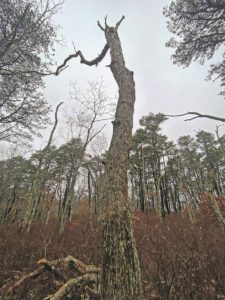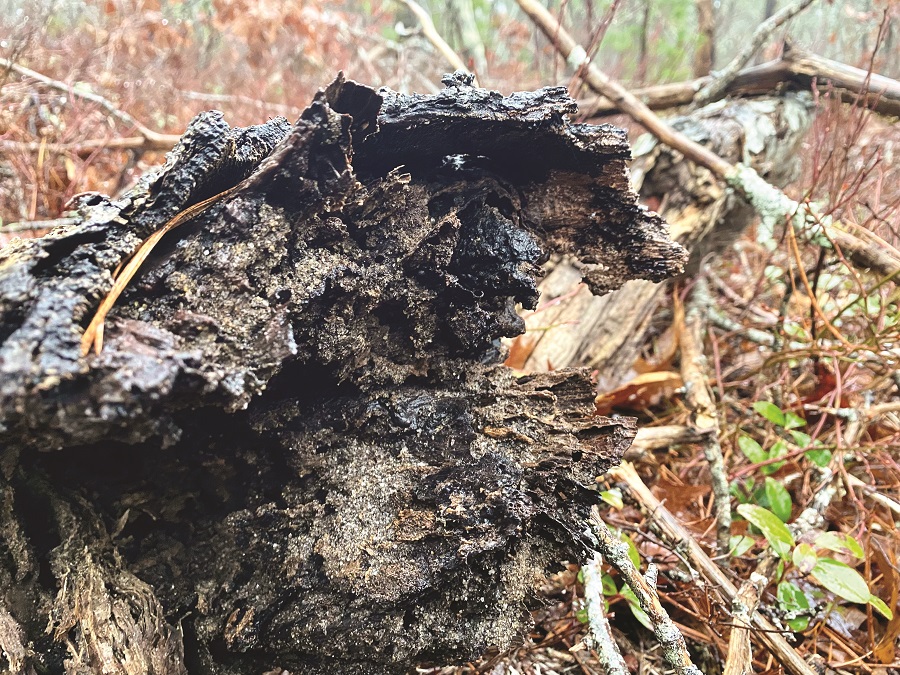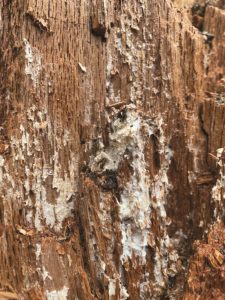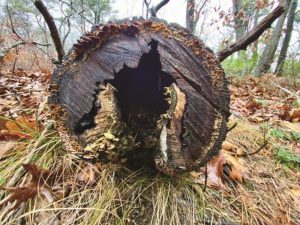On a walk in the Wellfleet woods a few days back I came upon a sort of ghost forest. At the trail’s edge and as far out into the underbrush as I could see were dead and fallen trees. Hundreds of them, their sun-bleached limbs crossed up in broken piles or arched like giant curved rib bones, were scattered across the naked huckleberry. Some still stood, bare frameworks, branches reaching up toward the open sky their leaves once filled.

Most of these trees died years ago after the invasion of gypsy moth caterpillars was followed by a series of droughts. They are now returning to the soil.
A pest, a drought, a pathogen produces some damage a tree cannot recover from, and the balance of living and not living tips. It dies. A tree will often stand for several years afterwards. The bark begins to fall away. The smaller branches break off in the wind and fall to the forest floor. As the wood begins to break down it absorbs moisture into its core. Even in death, the function of drawing and retaining moisture and passing it from empty hollow cell to empty hollow cell continues.
Insects move into the tree. They tunnel and feed and breed in this tower of tissue and nutrients. Beetles burrow in and lay eggs. Larvae hatch and tunnel, leaving space where there was wood. Life draws life. Woodpeckers come. They chisel holes into the softening wood with sharp beaks and relentless hacking. These holes allow moisture to make its way deeper into the wood. The cascade of breakdown accelerates.

One night, a strong wind blows. The roots of the tree have rotted and no longer provide support. The tree sways and falls, crashing down to the ground with a dull thump.
Now, all that lives in the earth moves into its mass.
In the night, rodents visit the tree. Raccoons and skunks press their claws and teeth to the decaying edges of this colony, ripping away chunks as they follow their instincts toward fat, juice-filled grubs.
Salamanders burrow into its soft underside. Worms work at its edges. The segmented, orange bodies of centipedes slide between thin layers. Round, armored sow bugs climb in and munch with their crustacean mandibles.

And the great deconstructer of material and creator of life moves in: Mycelial hyphae, thin-as-a-whisper branches of fungi, expand into every single grain of the tree’s substance, dismantling it chemically, withdrawing nutrients through a thousand miles of filament.
The tree is host to a churning, life-generating system. There may be as much life energy in this tree now as when it stood green and full of leaves.
Eventually, the supportive structure of the wood’s grain falls. And when it does, the rounded form of the log flattens and settles, sides buckled, brown, soggy. The once-hard wood is now soft powder, silky to the touch of a human hand. It shifts in the wind and the rain, settling into the very soil from which it once drew nutrients.

The tree is no longer wood but elements: nitrogen, potassium, phosphorus, carbon. All composed of atoms that once vibrated at the center of stars. They shift and settle into the dirt, nestled in with a million others, waiting with the calm patience only 13.7 billion years of existence can bring about.
Of all the atoms in the universe, how fortunate that these few landed here on Earth by chance to participate in the drama of life. One day, in the Wellfleet woods, an acorn falls, and a root reaches intuitively into the soil. An atom is drawn in, shaken by a burst of energy, and is once again alive.



